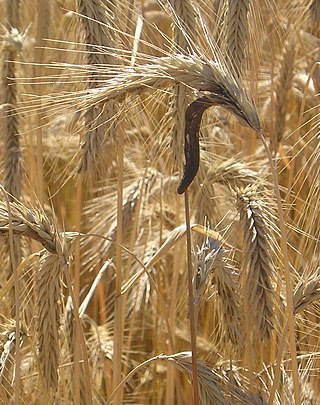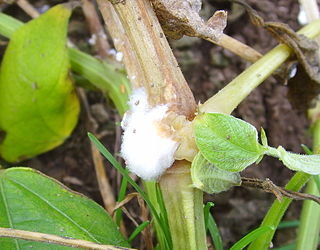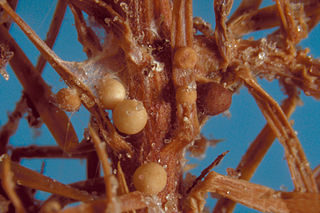
Phytophthora infestans is an oomycete or water mold, a fungus-like microorganism that causes the serious potato and tomato disease known as late blight or potato blight. Early blight, caused by Alternaria solani, is also often called "potato blight". Late blight was a major culprit in the 1840s European, the 1845–1852 Irish, and the 1846 Highland potato famines. The organism can also infect some other members of the Solanaceae. The pathogen is favored by moist, cool environments: sporulation is optimal at 12–18 °C (54–64 °F) in water-saturated or nearly saturated environments, and zoospore production is favored at temperatures below 15 °C (59 °F). Lesion growth rates are typically optimal at a slightly warmer temperature range of 20 to 24 °C.

Botrytis cinerea is a necrotrophic fungus that affects many plant species, although its most notable hosts may be wine grapes. In viticulture, it is commonly known as "botrytis bunch rot"; in horticulture, it is usually called "grey mould" or "gray mold".

Phytophthora is a genus of plant-damaging oomycetes, whose member species are capable of causing enormous economic losses on crops worldwide, as well as environmental damage in natural ecosystems. The cell wall of Phytophthora is made up of cellulose. The genus was first described by Heinrich Anton de Bary in 1875. Approximately 210 species have been described, although 100–500 undiscovered Phytophthora species are estimated to exist.

Phytophthora cinnamomi, also known as cinnamon fungus, is a soil-borne water mould that produces an infection which causes a condition in plants variously called "dieback", "root rot", or, "ink disease".

A sclerotium, is a compact mass of hardened fungal mycelium containing food reserves. One role of sclerotia is to survive environmental extremes. In some higher fungi such as ergot, sclerotia become detached and remain dormant until favorable growth conditions return. Sclerotia initially were mistaken for individual organisms and described as separate species until Louis René Tulasne proved in 1853 that sclerotia are only a stage in the life cycle of some fungi. Further investigation showed that this stage appears in many fungi belonging to many diverse groups. Sclerotia are important in the understanding of the life cycle and reproduction of fungi, as a food source, as medicine, and in agricultural blight management.
Phytophthora sojae is an oomycete and a soil-borne plant pathogen that causes stem and root rot of soybean. This is a prevalent disease in most soybean growing regions, and a major cause of crop loss. In wet conditions the pathogen produces zoospores that move in water and are attracted to soybean roots. Zoospores can attach to roots, germinate, and infect the plant tissues. Diseased roots develop lesions that may spread up the stem and eventually kill the entire plant. Phytophthora sojae also produces oospores that can remain dormant in the soil over the winter, or longer, and germinate when conditions are favourable. Oospores may also be spread by animals or machinery.

Phytophthora palmivora is an oomycete that causes bud-rot of palms, fruit-rot or kole-roga of coconut and areca nut. These are among the most serious diseases caused by fungi and moulds in South India. It occurs almost every year in Malnad, Mysore, North & South Kanara, Malabar and other areas. Similar diseases of palms are also known to occur in Sri Lanka, Mauritius, and Sumatra. The causative organism was first identified as P. palmivora by Edwin John Butler in 1917.

Damping off is a horticultural disease or condition, caused by several different pathogens that kill or weaken seeds or seedlings before or after they germinate. It is most prevalent in wet and cool conditions.

Phytophthora cactorum is a fungal-like plant pathogen belonging to the Oomycota phylum. It is the causal agent of root rot on rhododendron and many other species, as well as leather rot of strawberries.

Phytophthora erythroseptica—also known as pink rot along with several other species of Phytophthora—is a plant pathogen. It infects potatoes causing their tubers to turn pink and damages leaves. It also infects tulips (Tulipa) damaging their leaves and shoots.

Sclerotinia sclerotiorum is a plant pathogenic fungus and can cause a disease called white mold if conditions are conducive. S. sclerotiorum can also be known as cottony rot, watery soft rot, stem rot, drop, crown rot and blossom blight. A key characteristic of this pathogen is its ability to produce black resting structures known as sclerotia and white fuzzy growths of mycelium on the plant it infects. These sclerotia give rise to a fruiting body in the spring that produces spores in a sac which is why fungi in this class are called sac fungi (Ascomycota). This pathogen can occur on many continents and has a wide host range of plants. When S. sclerotiorum is onset in the field by favorable environmental conditions, losses can be great and control measures should be considered.
Alternaria dauci is a plant pathogen. The English name of the disease it incites is "carrot leaf blight".

Alternaria solani is a fungal pathogen that produces a disease in tomato and potato plants called early blight. The pathogen produces distinctive "bullseye" patterned leaf spots and can also cause stem lesions and fruit rot on tomato and tuber blight on potato. Despite the name "early," foliar symptoms usually occur on older leaves. If uncontrolled, early blight can cause significant yield reductions. Primary methods of controlling this disease include preventing long periods of wetness on leaf surfaces and applying fungicides. Early blight can also be caused by Alternaria tomatophila, which is more virulent on stems and leaves of tomato plants than Alternaria solani.

Phytophthora capsici is an oomycete plant pathogen that causes blight and fruit rot of peppers and other important commercial crops. It was first described by L. Leonian at the New Mexico State University Agricultural Experiment Station in Las Cruces in 1922 on a crop of chili peppers. In 1967, a study by M. M. Satour and E. E. Butler found 45 species of cultivated plants and weeds susceptible to P. capsici In Greek, Phytophthora capsici means "plant destroyer of capsicums". P. capsici has a wide range of hosts including members of the families Solanaceae and Cucurbitaceae as well as Fabaceae.

Phytophthora lateralis is a soil-borne plant pathogen that causes cedar root disease in Lawson cypresses in Northern USA. This pathogen was first noted to cause disease in around 1920 on nursery stock near Seattle. Pacific yew is also vulnerable to P. lateralis but less susceptible than Lawson cypress trees, and tree mortality has only been observed in areas where C. lawsoniana trees were also infected. Asiatic species of Chamaecyparis are generally described as resistant to P. lateralis, although this pathogen is occasionally isolated from Chamaecyparis obtusa in nurseries.
Alternaria helianthi is a fungal plant pathogen causing a disease in sunflowers known as Alternaria blight of sunflower.
Phytophthora quercina is a papillate homothallic soil-borne plant pathogen causing root rot of oak tree species in Europe. It is associated with necrotic fine roots.
Buckeye rot of tomato is caused by three species of pathogens in the genus Phytophthora: P. nicotianae var. parasitica, P. capsici, and P. drechsleri. It is an oomycete that thrives in warm, wet conditions and lives in the soil. It is characterized by a bull’s eye pattern of dark brown rotting on the tomato fruit, and affects fruit that is close to, or lying on the soil. The easiest management is to keep the plant out of contact with the soil, although other chemical methods can be very effective. This disease commonly occurs in the southeast and south central areas of the United States. The disease has affected a large portion of crop yield in the United States as well as India. The relatively small genome size of Phytophthora parasitica compared to Phytophthora infestans gives researchers the unique ability to further examine its ability to cause disease.

Agroathelia rolfsii is a corticioid fungus in the order Amylocorticiales. It is a facultative plant pathogen and is the causal agent of "southern blight" disease in crops.















